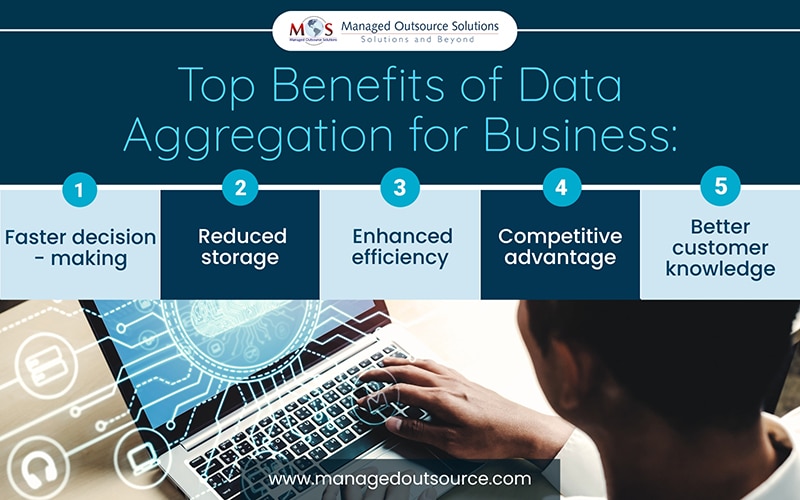Data is one of the key pillars that uphold the current AI-driven economy. As per an IDC report, the global data sphere is expected to reach 175 zettabytes by 2025. While this brings in opportunities for businesses, it also comes with challenges as information flows in from various channels such as supply chains, customer interactions, marketing tools, and internal operations. Collecting records is only the initial step, the real challenge lies in processing and analyzing it efficiently. This is where data aggregation boosts business strategy by enabling teams to organize information into a usable format. Whether it’s planning a quarterly strategy or adjusting daily workflows, the ability to extract relevant insights from multiple inputs can have a direct impact on how well a company performs. Since this process requires specialized expertise and niche business intelligence tools, hiring professional data processing services is a practical solution to secure valuable insights without depleting internal resources.
What is Data Aggregation and How Does it Help Companies?
Data aggregation is the process of finding, collecting, and combining data from a set of sources and reporting it in a summarized format. By merging information into a comprehensive database, this process facilitates efficient analysis and data-driven decision-making. Companies can utilize this process in diverse functions such as statistical analysis, project reporting, sales forecasting, and annual performance review.
A manufacturing firm, for example, could consolidate information from its production line, supply chain, and sales force to track inventories and predict demand. This not only enables firms to obtain an end-to-end view of their enterprise, but also reduces the need to constantly dig through individual records. It helps business intelligence teams and analysts discover patterns, trends, and opportunities that may not be apparent in individual summaries.
In addition, consolidating records can also help organizations recognize new opportunities in the market, increase operational efficiency, identify bottlenecks, and improve customer experience. Organizations can perform it manually or automate it with the help of specialized software to maximize efficiency and minimize human error.
Additionally, pooling information can help organizations identify new market opportunities, boost sales performance, detect and address bottlenecks, and enhance the customer experience. Businesses can either perform it manually or automate using specialized tools to enhance efficiency and reduce human error. With data-driven insights generated from aggregated reports, organizations can optimize various facets of their functions ranging from production and marketing, to internal operations and customer retention management.
Key Benefits of Data Aggregation for Business
Data aggregation brings unique benefits to businesses in ways other information procedures may not. Here’s why it’s especially valuable:
- Faster decision-making: Managers don’t have to sift through separate reports and instead, get immediate insights as aggregation combines disparate datasets into comprehensive view. This makes it easier to spot trends, uncover risks, and identify opportunities, leading to better and faster strategic decisions.
- Reduced storage: Companies may store information in disparate storage systems such as data warehouses and lake houses, which makes it complex to analyze information. Consolidating and centralizing these scattered data points provides a unified view. This ensures all stakeholders, decision-makers have access to the same information, bridging gaps and improving collaboration.
- Enhanced efficiency: Instead of running complex queries on individual data points manually and repeatedly, automated aggregation tools pre-calculate the results. This minimizes the strain and redundancies from systems, boosting database performance, operational efficiency, and productivity levels.
- Competitive advantage: Whether it’s predicting sales, customer behavior analysis, or market trends, aggregating information allows companies analyze past data and forecast future performance more accurately. By highlighting broader insights that may not be obvious when viewed in isolation, aggregation lets businesses stay ahead of competitors and plan for future growth wisely.
- Better customer knowledge: Analyzing customer metrics in isolation may lead to inaccuracies or errors. Consolidating information can help businesses to gain deeper and better knowledge of customer behavior. By merging customer details for granular view, companies can better allocate resources for improved personalization and targeted marketing activities.
Types of Data Aggregation
While data aggregation can be done in multiple ways, businesses need to choose the most suitable option based on their requirements. Here are some of the most common methods:
- Time-based: In this type, data points related to a single area are collected over a period of time. For example, companies may monitor website traffic rates by days, months, or year in order to examine trends, seasonality, and performance changes over time.
- Spatial: Datasets are aggregated based on geographical location, such as cities, states or countries. For instance, a retail company may aggregate based on delivery times by city to compare and rank bestselling products across different regions.
- Categorical: The database is grouped and summarized according to categories or labels such as product types, customer segments, or geographic locations. For instance, sales information can be grouped by region or product category to reveal top-performing segments, discover new prospects, and find root cause of challenges.
- Hierarchical: The database is combined at various levels of granularity, traditionally in an organizational or information structure hierarchy. For example, sales information could be rolled up from individual stores to regional, national, and global levels.
- Statistical: Instead of simple summations, this type uses statistical measures such as averages, medians, percentiles, or variances to summarize information, providing deeper insights into distributions and variability.
Selecting the right aggregation type depends on the specific analysis goals, company objectives, and business context to provide meaningful and actionable insights.
Best Practices for Effective Data Aggregation in 2025
Businesses can deliver genuine value with aggregation by executing the process with clear objective and clarity. Poorly planned processes can result in misinterpretation, duplication, or even loss of critical context. Below are some core practices that companies can implement to draw reliable insights:
Set specific objectives: Before starting the process, companies should understand why they are aggregating databases and what decisions they aim to support. From identifying sales patterns to customer churn tracking, or performance monitoring in operations, having specific objectives guarantees the selection of right information sets and processing..
Use trusted sources: The accuracy of aggregated data depends heavily on the quality of the input. Bringing together outdated, mismatched, or irrelevant information can introduce noise instead of clarity. It’s essential to verify the credibility of sources, maintain consistency, and include only what is needed for analysis..
Standardize data formats: While extracting information from different departments, tools, or platforms, discrepancies in format can lead to faulty conclusions. Standardizing units, formats, naming conventions, and other key attributes helps maintain consistency and avoid mismatches during predictive analysis..
Validate aggregated results: Before using the output for decisions, teams should test the accuracy of the aggregation. This includes verifying if the figures match raw data, identifying outliers, and confirming that nothing has been altered during the process. Routine validation can prevent severe errors and establish trust in the results..
Automate with caution: Though automation reduces time spent on processes, it should not replace human oversight. Automated tools must be reviewed constantly to make sure they are operating as expected and adapting to any modifications of the dataset structure or source systems..
Keep documentation updated: Multiple individuals from teams tend to depend on database systems. Companies must maintain clear and up-to-date documentation for explaining how aggregation is set up, including what data is used, how it’s processed, and stored. This makes it easier for teams to manage, scale, and troubleshoot as needed..
Protect privacy and access: Aggregated datasets may still contain sensitive information based on their structure. Organizations should apply access controls to limit exposure, comply with industry regulations, and safeguard customer and business confidentiality..
Implementing these best practices helps organizations to not just gather information, but also use it meaningfully. It creates a more stable foundation for decision-making, reduces the chances of error, and allows teams to stay focused on insights that drive the business forward. However, as applying this process may take time, effort, and resources away from core business activities, companies can partner with data conversion services to achieve their data aggregation goals. These external teams bring in technical expertise, tools, and frameworks to drive strategic outcomes.





